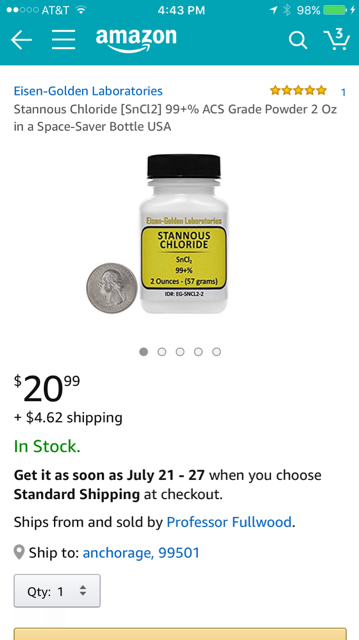So I have a couple years experience with gold recovery and chemistry, but not refining gold. I recovered foils off of fingers I have saved for 8 months. I felt I had sufficient foils to refine, so I did. I dissolved them in AR but measured the AR before dissolving, rather than adding Nitric until it just dissolves the gold. I remembered excess free nitric is not good for precipitating. So, while waiting for my Sodium Metabisulfite, I heated the gold in acid on a hot plate to dry it. I used low temps and stopped when it looked thick. While cooling, it dried. I re-dissolved it with distilled water.
After It was re-hydrated, I received my Sodium Metabisulfite and dropped the gold. It turned lighter in color immediately but took nearly 15 minutes for the gold to precipitate. I expect about 0.5 grams of gold, so I added (an excess) 2-2.5 grams of SMB for the precipitation.
Here's my issue.....
The gold is suspending a lot, so I let it settle for 30 minutes. A lot settled to the bottom, but a portion I don't want to decant is still floating in suspension. Also, on the surface is shiny particles of gold (leftover nitric issues?)
I attempted to decant it to another jar, but it seems impossible to remove the majority of the solution without decanting fine gold in suspension. I cooled it to aid in collection of the particles, let it sit another hour, and just keep fighting myself trying not to decant gold powder.
So, my question is, what should i do? I'm working with a small amount here and I really don't want jars sitting around forever with gold in the bottom I cant get out? I read coffee filters are a no-go. What are my options?
After It was re-hydrated, I received my Sodium Metabisulfite and dropped the gold. It turned lighter in color immediately but took nearly 15 minutes for the gold to precipitate. I expect about 0.5 grams of gold, so I added (an excess) 2-2.5 grams of SMB for the precipitation.
Here's my issue.....
The gold is suspending a lot, so I let it settle for 30 minutes. A lot settled to the bottom, but a portion I don't want to decant is still floating in suspension. Also, on the surface is shiny particles of gold (leftover nitric issues?)
I attempted to decant it to another jar, but it seems impossible to remove the majority of the solution without decanting fine gold in suspension. I cooled it to aid in collection of the particles, let it sit another hour, and just keep fighting myself trying not to decant gold powder.
So, my question is, what should i do? I'm working with a small amount here and I really don't want jars sitting around forever with gold in the bottom I cant get out? I read coffee filters are a no-go. What are my options?






